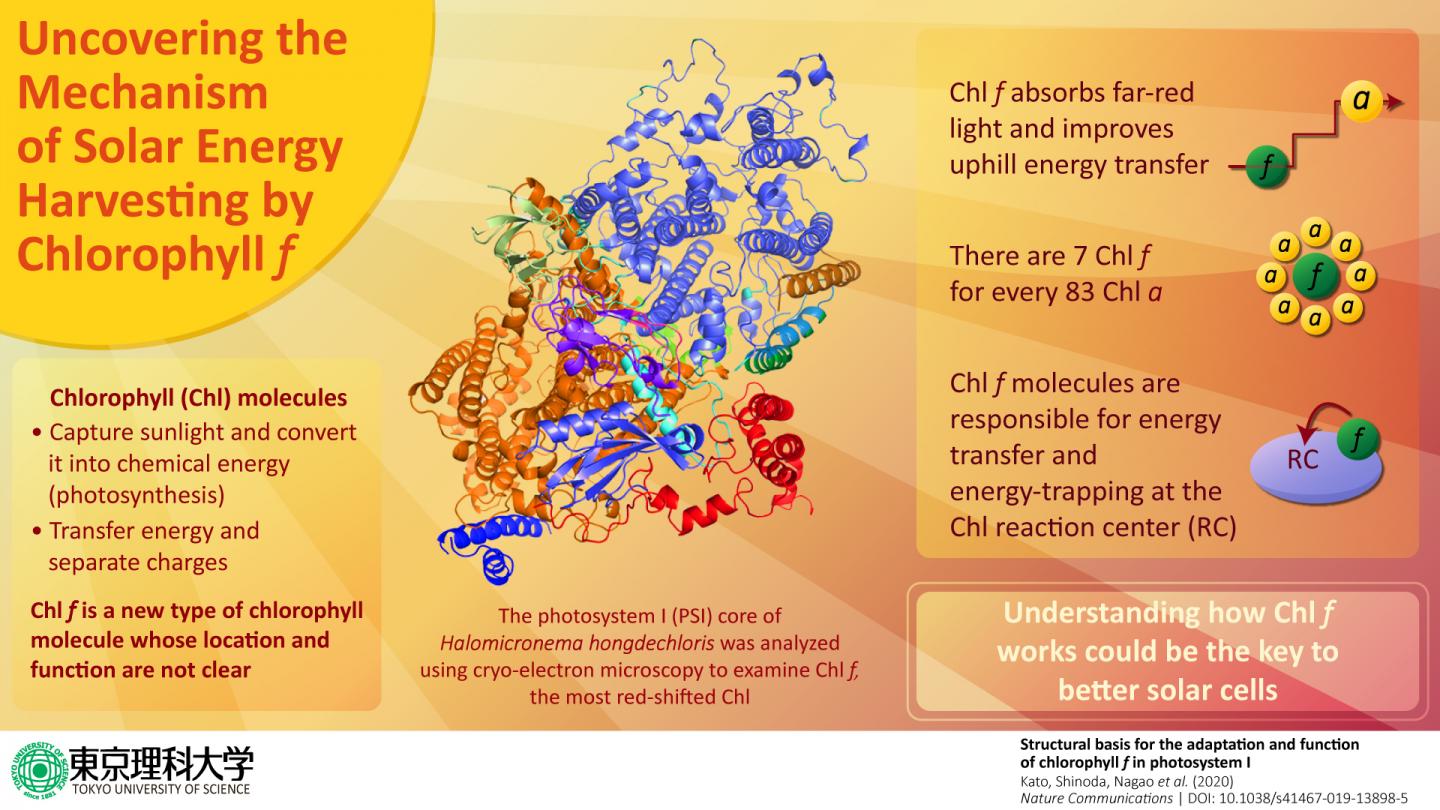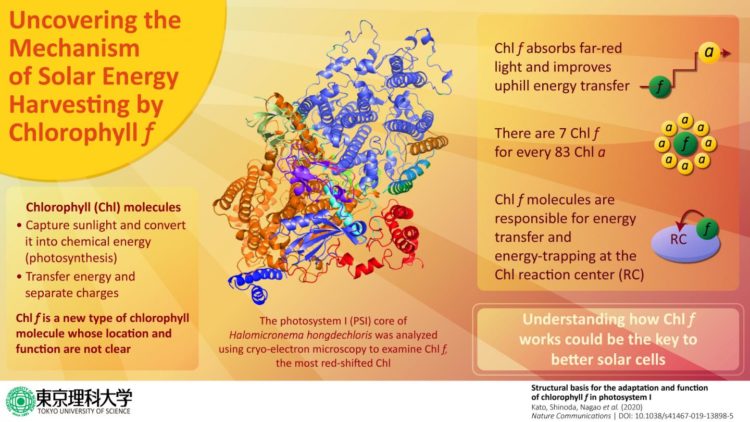Scientists uncover the location and functions of a new type of chlorophyll molecule for the first time

Credit: Tokyo University of Science
All living organisms need energy for their survival, and this energy indirectly comes from the sun. Some organisms, such as plants, cyanobacteria, and algae, are capable of directly converting this light energy into chemical energy via a process called “photosynthesis”. These photosynthetic organisms contain special structures to mediate photosynthesis, called “photosystems”. There are two photosystems that carry out light-energy conversion reactions, each of which is composed of a number of proteins and pigments. Among photosynthetic pigments, chlorophyll is the most crucial one, which not only captures light energy from the sun but also participates in the “electron transfer chain”, a molecular pathway through which photons (from the sunlight) are converted into electrons (which are used as an energy source). There are different types of chlorophyll molecules, each having a specific function ranging from absorbing light and converting it into energy. Moreover, each chlorophyll molecule absorbs light in different regions. Recently, a new type of chlorophyll called Chl f was discovered, but details like exactly where it is located and how it functions have remained a mystery until now.
In a new study published in Nature Communications, a team of researchers led by Prof. Tatsuya Tomo at the Tokyo University of Science, Japan, and including collaborating researchers from Okayama University, Tsukuba University, Kobe University, and RIKEN, revealed new details about the location and functions of Chl f. They wanted to gain insight into the complex process of photosynthesis, as an in-depth understanding of this process could have various future applications, such as the development of solar cells. Talking about the study, Prof. Tomo says, “The initial course of photosynthesis begins when the photosynthetic pigment bound to this photochemical complex absorbs light. We analyzed the structure of a newly discovered photochemical complex, photosystem I with Chl f that has an absorption maximum on the lower energy side of light (far-red light). Moreover, we analyzed the function of Chl f.”
What the scientists knew so far was that Chl f is “far-red shifted,” which means that this molecule absorbs far-red light from the lower end of the light spectrum. Prof. Tomo and his team wanted to dig deeper, and for this, they studied the alga in which Chl f was first discovered. By using techniques such as cryo-electron microscopy, they analyzed the high-resolution structure of the photosystem in this alga in detail and found that Chl f is located at the periphery of photosystem I (one of the two types of photosystems) but is not present in the electron transfer chain. They also found that far-red light causes structural changes in the photosystem, which are accompanied by the synthesis of Chl f in the algae, leading them to conclude that Chl f causes these structural changes in photosystem I. This was exciting, as this finding is the first to explain how exactly Chl f works. Prof Tomo says, “Our findings revealed that the appearance of Chl f is well correlated with the expression of photosystem I genes induced under far-red light. This indicates that Chl f functions to harvest the far-red light and enhance up-hill energy transfer. We also found that the amino acid sequence of photosystem I was altered so as to accommodate the structure of Chl f.”
Understanding the intricacies of photosynthesis has several important applications. For example, mimicking the process of photosynthesis in an artificial system is an elegant method of capturing solar energy and converting it into electricity. Prof Tomo elaborates, “About half of the solar energy that falls on the earth is visible light, and the other half is infrared light. Our research puts forth a mechanism that can use light on the lower energy spectrum, which has never been seen before. Our findings show how to improve the efficiency of energy transfer in photosynthesis and, by extension, also provide important insights into artificial photosynthesis.”
###
About The Tokyo University of Science
Tokyo University of Science (TUS) is a well-known and respected university, and the largest science-specialized private research university in Japan, with four campuses in central Tokyo and its suburbs and in Hokkaido. Established in 1881, the university has continually contributed to Japan’s development in science through inculcating the love for science in researchers, technicians, and educators.
With a mission of “Creating science and technology for the harmonious development of nature, human beings, and society”, TUS has undertaken a wide range of research from basic to applied science. TUS has embraced a multidisciplinary approach to research and undertaken intensive study in some of today’s most vital fields. TUS is a meritocracy where the best in science is recognized and nurtured. It is the only private university in Japan that has produced a Nobel Prize winner and the only private university in Asia to produce Nobel Prize winners within the natural sciences field.
Website: https:/
Media contacts
Tsutomu Shimizu
Public Relations Divisions
Tokyo University of Science
Email: [email protected]
Website: https:/
Okayama University
Email: [email protected]
Website: http://www.
University of Tsukuba
Email: [email protected]
RIKEN
Email: [email protected]
Kobe University General Affairs Department Communications Division
E-mail: [email protected]
Funding information
This study was supported by the Platform Project for Supporting Drug Discovery and Life Science Research (Basis for Supporting Innovative Drug Discovery and Life Science Research [BINDS]) from AMED, PRESTO from JST Grant no. JPMJPR16P1, JSPS KAKENHI no. JP17K07442, JP19H04726, JP17H06434, no. 17726220801, 17K07453, 18H05177, JP19K22396, along with the JSPS-RFBR grant (no. 19-54-50002).
Media Contact
Tsutomu Shimizu
[email protected]
Related Journal Article
http://dx.





